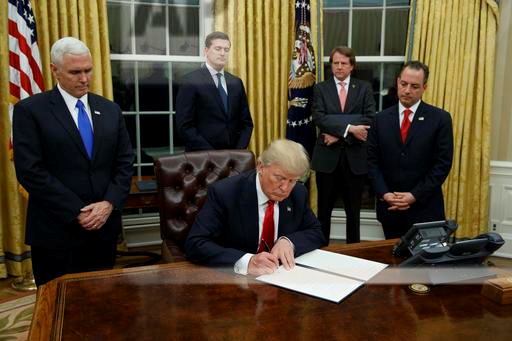What’s up with President Trump?: Executive Orders
February 7, 2017
The Trump Administration spared no time when it came to President Trump’s campaign promises. On his second day in office Trump got to work and signed three executive orders. In total Trump has signed seven executive orders since he was sworn in on January 20th. What is a executive order? It is a order that the President uses to set a policy in place without congress approving. Although it is set in place, it is not officially a law since congress has not approved. Here are the orders that President Trump has signed.
Trans Pacific Partnership. This was a trade deal between the United States and eleven other nations in the Asia-Pacific region. This agreement would eliminate any tariffs and lightened up trade regulations between those countries. Trump said that it was hindering the American worker.
Mexico City Policy. This policy required all non-governmental organizations that receive federal funding to stop performing or promoting any abortion activity. The policy was originally initiated by President Reagan but was soon rescinded by his successors. Trump reinstated it the policy after eight years of it being dead.
Freezing Federal Workforce Hiring. This policy would freeze the hiring of federal employees for 90 days. Military and public safety workers are exempt from the ban.
Boarder Security and Immigration Enforcement Improvements. This order would provide boarder protection agencies with the necessary materials to prevent illegal immigration into the country.
Protecting the Nation from Foreign Terrorist Entry into the United States. This policy restricts immigration from Iraq, Iran, Libya, Somalia, Sudan, Syria, and Yemen for 90 days. This order is the most controversial.
Reducing Regulation and Controlling Regulatory Costs. This order directs agencies to get rid of two existing regulations for every new regulation signed. They have to do this in a way that doesn’t raise the costs of the regulation.
Expediting Environmental Reviews and Approvals for High Priority Infrastructure Projects. This order promotes competition within the American workforce. It also gives a go ahead to the construction of the Keystone XL and Dakota Access oil pipelines.











